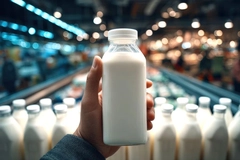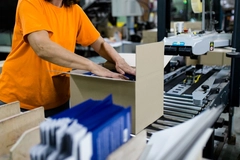Top food firms interested in novel food freshness label, entrepreneur
21 Feb 2011

A Scottish entrepreneur claims that two top food manufacturers and a major supermarket have shown interest in licensing an innovative colour-changing label that tells consumers how fresh their food is, which could be used on products within 12 months.
A Scottish entrepreneur claims that two top food manufacturers and a major supermarket have shown interest in licensing an innovative colour-changing label that tells consumers how fresh their food is, which could be used on products within 12 months.
The UWI Label: Appearing on a supermarket shelf near you within 12-18 months?
According to Strathclyde University research, around 8.3m tonnes of food are wasted in the UK every year, where consumers buy jarred or bottled products with a six-week shelf life, but forget how long it has sat in the cupboard or fridge and throw it away.
Pete Higgins from Liberton-based UWI Label said that his firm’s patent-pending system – which has been nominated for a John Logie Baird scientific innovation award – uses chemical means taken from another industry to ascertain how fresh food is.
Elapsed time indicator
UWI’s label (pictured) which is integrated into labelling, has a green strip that indicates food age in weeks on a scale of 1-4. Once reached, a red square at the end indicates that the food is no longer edible. The product is unique, Higgins said, because it is the only one he knows of that users an ‘elapsed time indicator’ to trigger a time device when the product is opened.
UWI Label developed the technology over three years with help from Heriot Watt University, said Higgins, with the firm initially developed an electronic prototype, then an electronic/chemical hybrid, before settling on a wholly chemical indicator:
“The boon of the product is that it withstands temperature changes, and is equally effective in both the cupboard and fridge: electronics are more costly and sensitive to temperature changes.”
Higgins says his label, which reportedly doesn’t work on tins, is “adaptable to so many markets, so the potential is huge, but the problem just now is the price point. The pharmaceutical market can stand a higher initial price point, and economies of scale lessen the cost later on”.
He added that UWI was talking to two major, food manufacturers about investing in the product: “It’s more difficult to get into the food market, but we are also in discussions with a major supermarket and the product is attractive to them: supermarkets spend millions on loyalty and branding, but can’t be seen to profit from consumer wastage.”
Win-win scenario for retailers
If this were reduced significantly, Higgins added, then it was a win-win situation for retailers, consumers and UWI Label itself. Given that the label would only costs only “a few pence”, he believes that retailers or major food firms would be willing to absorb or at least split the slight price premium the indicator would involve, given the positive sustainability message the product would allow them to make.
Higgins said the label could be used on food packaging within 12-18 months, if investment plans progress and his firm ties-up with a major commercial partner, although he predicts penetration into the pharmaceutical market by the end of the year, where the label can also be used on medicine bottles, pills and cosmetics.
Source: UWI Label
All content and features on this website are copyrighted with all rights reserved. The full details can be found in our privacy statement
Subscribe to our newsletters
By continuing to browse our site you agree to our Privacy Statement











